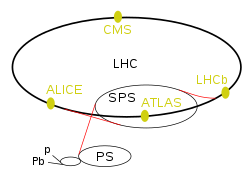
Back لولب مركب للميون Arabic CMS (детектор) Bulgarian কম্প্যাক্ট মিউওন সলিনয়েড Bengali/Bangla Solenoide compacte per a muons Catalan Compact Muon Solenoid German CMS (πείραμα) Greek Experimento CMS Spanish سیملوله فشرده میونی Persian CMS (koelaitteisto) Finnish CMS (expérience) French
46°18′34″N 6°4′37″E / 46.30944°N 6.07694°E
 Plan of the LHC experiments and the preaccelerators. | |
| LHC experiments | |
|---|---|
| ATLAS | A Toroidal LHC Apparatus |
| CMS | Compact Muon Solenoid |
| LHCb | LHC-beauty |
| ALICE | A Large Ion Collider Experiment |
| TOTEM | Total Cross Section, Elastic Scattering and Diffraction Dissociation |
| LHCf | LHC-forward |
| MoEDAL | Monopole and Exotics Detector At the LHC |
| FASER | ForwArd Search ExpeRiment |
| SND | Scattering and Neutrino Detector |
| LHC preaccelerators | |
| p and Pb | Linear accelerators for protons (Linac 4) and lead (Linac 3) |
| (not marked) | Proton Synchrotron Booster |
| PS | Proton Synchrotron |
| SPS | Super Proton Synchrotron |

The Compact Muon Solenoid (CMS) experiment is one of two large general-purpose particle physics detectors built on the Large Hadron Collider (LHC) at CERN in Switzerland and France. The goal of the CMS experiment is to investigate a wide range of physics, including the search for the Higgs boson, extra dimensions, and particles that could make up dark matter.
CMS is 21 metres long, 15 m in diameter, and weighs about 14,000 tonnes.[1] Over 4,000 people, representing 206 scientific institutes and 47 countries, form the CMS collaboration who built and now operate the detector.[2] It is located in a cavern at Cessy in France, just across the border from Geneva. In July 2012, along with ATLAS, CMS tentatively discovered the Higgs boson.[3][4][5] By March 2013 its existence was confirmed.[6]
- ^ "Archived copy" (PDF). Archived from the original (PDF) on 2014-10-18. Retrieved 2014-10-18.
{{cite web}}: CS1 maint: archived copy as title (link) - ^ "CMS Collaboration - CMS Experiment". cms.cern. Retrieved 28 January 2020.
- ^ Biever, C. (6 July 2012). "It's a boson! But we need to know if it's the Higgs". New Scientist. Retrieved 2013-01-09.
'As a layman, I would say, I think we have it,' said Rolf-Dieter Heuer, director general of CERN at Wednesday's seminar announcing the results of the search for the Higgs boson. But when pressed by journalists afterwards on what exactly 'it' was, things got more complicated. 'We have discovered a boson – now we have to find out what boson it is'
Q: 'If we don't know the new particle is a Higgs, what do we know about it?' We know it is some kind of boson, says Vivek Sharma of CMS [...]
Q: 'are the CERN scientists just being too cautious? What would be enough evidence to call it a Higgs boson?' As there could be many different kinds of Higgs bosons, there's no straight answer.
[emphasis in original] - ^
Siegfried, T. (20 July 2012). "Higgs Hysteria". Science News. Retrieved 2012-12-09.
In terms usually reserved for athletic achievements, news reports described the finding as a monumental milestone in the history of science.
- ^
Del Rosso, A. (19 November 2012). "Higgs: The beginning of the exploration". CERN Bulletin. Retrieved 2013-01-09.
Even in the most specialized circles, the new particle discovered in July is not yet being called the "Higgs boson". Physicists still hesitate to call it that before they have determined that its properties fit with those the Higgs theory predicts the Higgs boson has.
- ^ O'Luanaigh, C. (14 March 2013). "New results indicate that new particle is a Higgs boson". CERN. Retrieved 2013-10-09.
© MMXXIII Rich X Search. We shall prevail. All rights reserved. Rich X Search